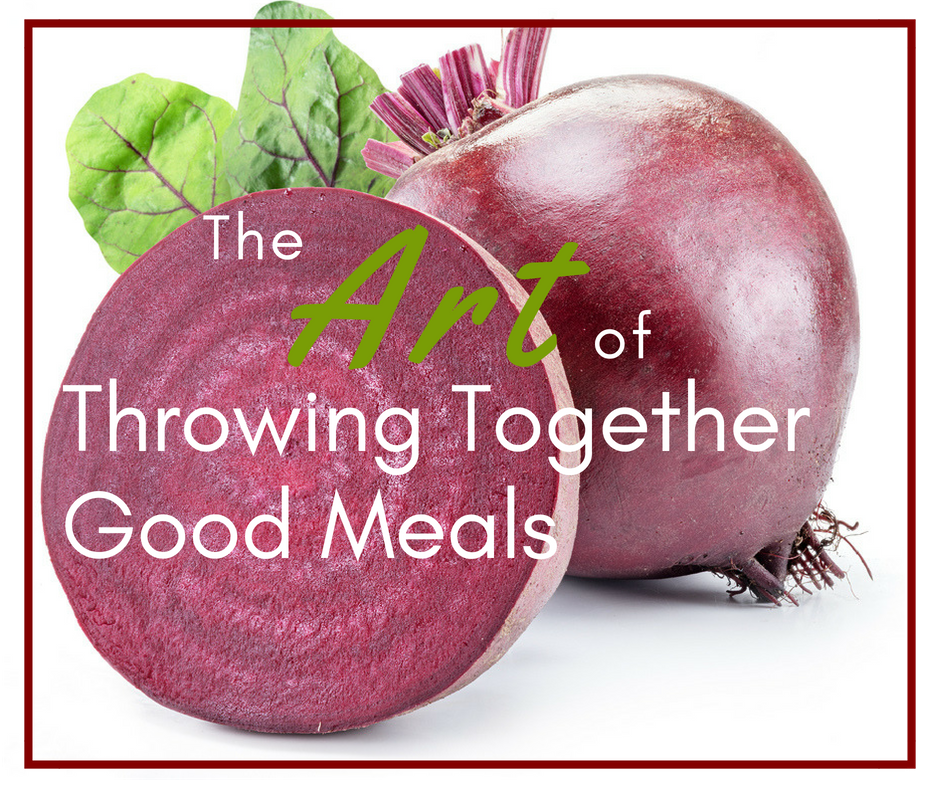
Did you know there are people “out there” who pull good meals together, day after day, no big deal. You may be one of them, but if not, would you like to be?
Take my CSA* for instance. A couple days ago, one member posted a Facebook query about how to use the beets she got in our weekly share. Within 24 hours, no less than 18 great ideas were posted. Most fell into the “throw-it-together” category, like these two ideas:
“We do a root vegetable slaw with carrots, beets, and turnips. Grate them all raw and combine. Dress with salad dressing or don’t.”
“I’ve been making beet bowls and they’re so easy. Just brown rice, pan or oven roasted beets and onions, garlic, some sort of green veggie and shrimp or chicken. Then I add a little mayonnaise to make it creamy and mix it up. Sounds weird but it’s super good. It’s got the sweet and savory thing going.”
It’s clear these, and all the other posters are not stressed, overwhelmed or confused about using up a bunch of beets. In fact, they are excited and jazzed at the prospect!
Would you love to have this joy in your life, too?
For starters, you’ve got to remember that it’s possible. The convenience food industry has worked tirelessly to erase our cultural memory that meal making is something that’s possible. It has beaten us down with marketing messages to make us believe that ordinary people don’t have the time or ability to make our own meals. (Because then you’ll opt for their products!)
But that’s a myth. Right now, ditch it. It is absolutely possible for you to be one of the many people throwing together great meals, day after day. Here are the steps:
Step 1. Learn your Legos® Did you see how the ideas above didn’t include a lot of detail? Instead, they just said, “grate” and “dress.” Or “roast,” or “throw in some chicken or shrimp.”
That’s because the writers know how to roast. And they know how to grate (what tool works best, what size of grate is good, whether to peel or not.) And they know how to cook chicken or shrimp–and especially how to have some on hand as leftovers. And once you know how to do these things, you do them over and over again for hundreds of different recipes.
Basically that’s all cooking is: Mixing and matching a few fundamental techniques.
Did you or your kids ever play with Legos®? Remember how a single set of blocks could be transformed into anything from a futuristic building to a rocket ship? The same is true for cooking. It can seem so mysterious, but really it’s just using and re-using the same basic building blocks, over and over, just with different ingredients.
And the cool thing is that it doesn’t take many of what I call “Cooking Legos®” to make hundreds of great dishes! Maybe six or seven! You can do that!
Now for Step 2. Discover What Makes Your Taste Buds Sing Did you also notice that the CSA members didn’t specify what dressing might be good on the root veggie slaw? Or how much garlic or mayonnaise to use? That’s because they have paid attention to and know what flavors and foods make them feel happy and satisfied.
Another sad effect of our convenience food culture is the homogenization of our tastes. Food flavors are “dumbed down” so they appeal to the widest possible audience. Making matters worse, most packaged foods rely on artificial flavors, so you lose touch with the flavors of real foods and seasonings.
But what an adventure awaits once you start exploring different ingredients and flavors. Bit by bit, your taste buds will wake up and get excited to be called into action–and you’ll develop a sense of how flavors and ingredients work together to create wonderfully satisfying dishes.
Finally, Step 3: Courage and Practice Isn’t it crazy that we can feel nervous and even a little frightened by the act of making food? So at a point, it simply takes the force of courage to just do it. Know that there are ways to try new flavors without ruining an entire dish and also, that it is rare that you would make something inedible. Maybe a dish you won’t ever make again, but not something that just has to be tossed!
And yes, it will take effort and practice. All good things take time and engagement. No time, no good things.
But don’t get mired in moaning about time and effort. Focus on the benefits: Meal making that is not stressful or boring, boring, boring. Meal making that is manageable and even a little fun and creative. Plus food that’s yummy, satisfying and good for you.
You can do it!
Want a little help, motivation or inspiration? That’s what all my classes are about, and particularly Summer Camp. We can get you started or get you moving toward the wonderful Art of Throwing Together Good Meals. Join me!
*CSA stands for Community Supported Agriculture. You buy an “annual share” in a farm and then each week in the summer, you get a bag of gorgeous produce. Read more about the many excellent benefits of joining a CSA.